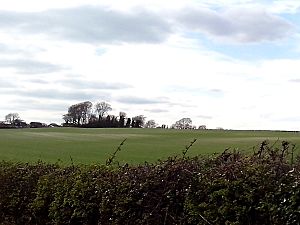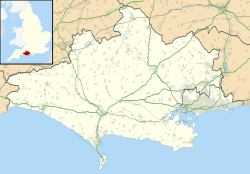Mount Pleasant henge facts for kids

Mount Pleasant Henge, visible as a white cropmark. Conquer Barrow is in the background
|
|
| Region | Dorset, England |
|---|---|
| Coordinates | 50°42′32″N 2°24′43″W / 50.708905°N 2.412072°W |
| Type | Henge |
| History | |
| Periods | Neolithic |
Mount Pleasant Henge is an ancient site in Dorset, England. It's a special type of enclosure built long ago, during the New Stone Age. You can find it southeast of Dorchester. Today, parts of it still exist as large mounds of earth.
Contents
What is Mount Pleasant Henge?
Mount Pleasant Henge is a very large ancient monument. It's like other "superhenge" sites, such as Durrington Walls. Over time, farming and weather have worn away much of its original shape.
How it was Found
People didn't know about Mount Pleasant Henge until Stuart Piggott visited the area in 1936. He was an archaeologist, a person who studies old things. He realized it was a henge because its bank was outside its ditch. This is a key feature of a henge.
Shape and Size
The enclosure is shaped like an egg. It measures about 370 meters (1,214 feet) along its longest side. Scientists believe it was built between 2878 and 2470 BC. A later Bronze Age burial mound, called Conquer Barrow, was built on top of its bank.
Exploring the Henge
In 1969, scientists used a special method called geophysical survey. This method helps them "see" what's underground without digging. They found entrances to the main henge. They also found a smaller henge inside, about 45 meters (148 feet) wide. This smaller henge was at the southwest end.
What Was Found Inside?
Archaeologists dug into the henge in the 1960s. They didn't find much in the main ditch. But they did find pieces of grooved pottery. They also found the skeletons of children.
The smaller inner henge was more interesting. It had many postholes. These are holes where wooden posts or stones once stood. The holes were in five circles, one inside the other. There were also cross-shaped paths leading to the center. Some holes in these paths might have held stones. This inner area was similar to other ancient timber circles, like The Sanctuary and Woodhenge.
The Giant Wooden Wall
Archaeologists also found a narrow trench, about 2 meters (6.6 feet) deep. This trench ran around the inside of the larger henge. It held huge oak timbers placed close together. This would have been a massive wooden wall or "palisade." It acted as a big barrier in the middle of the site.
The archaeologist Geoffrey Wainwright led the digging. He thought about 1,600 timbers stood in this trench. They enclosed an area of 45,000 square meters (11 acres). There were two narrow entrances in this wooden wall, each only 1 meter (3.3 feet) wide. Evidence showed that these timber posts had been burned.
Building Over Time
The wooden enclosure was built about 500 years after the main henge. Building this wooden wall meant the original earthworks had to be changed.
Importance of Mount Pleasant Henge
Mount Pleasant Henge is very important to understanding the past. It is the "type site" for the Mount Pleasant Period. This means it's the main example that helps define a specific time in the later Neolithic period.
Recent studies suggest that this huge henge was built quite quickly. It was likely finished in 35 to 125 years. Before, people thought it took many centuries to build.


